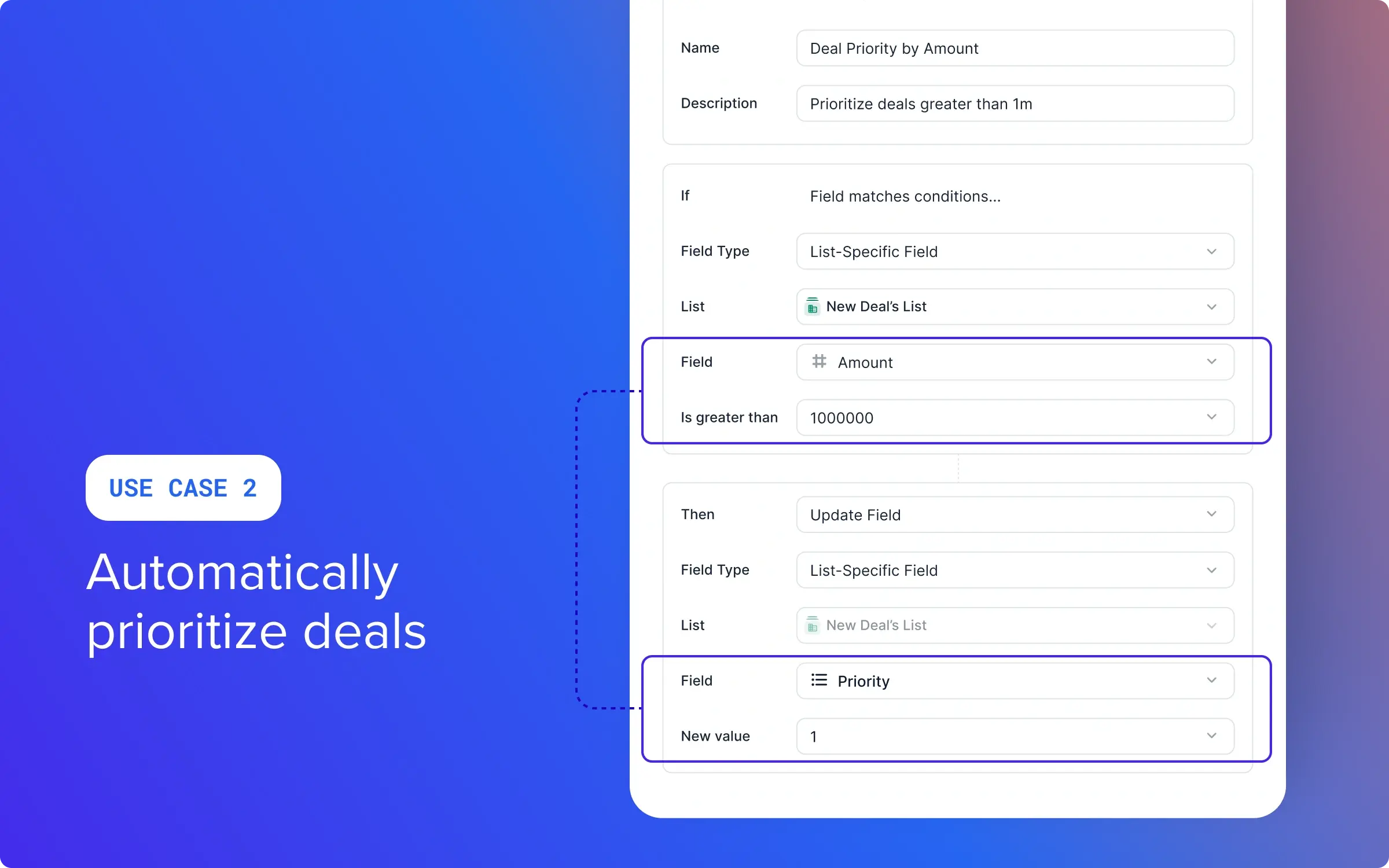Eliminating manual data entry is central to our purpose of building the leading CRM for private capital—and our new Automation Builder takes customers one step closer to this vision.
Up until now, Affinity’s top automation features have included the automatic creation of people and company profiles, and profile enrichment with Affinity data and data from third-party vendors. The Affinity CRM also automatically tracks engagement histories with each contact, and uses relationship intelligence to generate an accurate relationship strength.
These are essentially ‘set and forget’ automations that work the same way across all firms that manage their dealmaking in Affinity. But we know that many firms have needs and workflows that, while unique, are still regular and repeated enough that they can be automated away. This is where more personalized, custom automations come into play.
Now, Affinity users can set up if/then statements so that if the contents of a field meet a specific condition, then the contents of a second field will update based on the rule(s) of the automation. Automations are even possible from Affinity to Slack—see the use case below for full details!
These new automation capabilities help Operations/Platform Managers to ensure pipeline accuracy for reporting and analysis purposes. For investors, automations can dramatically decrease time spent manually entering data. This means the team can make faster decisions, and investors can refocus their time on higher value activities like meeting with founders or sourcing new companies to add to the deal pipeline.
Let’s explore five top use cases to see how the Automation Builder lets you define and autofill predictable deal information, reduces repetitive actions, and moves you faster towards later deal stages and better outcomes.
How to get started with the Automation Builder
- Begin by navigating from your Affinity homepage to Settings > Automations > New Automation.
- Give the automation a name and, if required, include a description to provide further insight on your Automations dashboard.
.webp)
- Select whether your ‘if’ trigger is on a list-specific or is a global field. Remember that selecting a global field here means that changes to this field on any list could impact other lists! Enriched fields are not yet available in the Automations Builder, which may require you to create fields manually for some use cases to work.
- If you’ve specified a list-specific field, select the list you’d like to apply the automation to.
- Next, set the criteria for triggering the automation. Choose your ‘if’ trigger field and the corresponding conditional operator to customize your trigger. A full list of these is available on our support site as they depend on the field type.
- Under ‘then’, select ‘Update field’.
- Select if the field where the automation should action a change is a field specific to this list, or a global field (again, selecting a global field could cause changes across other lists).
- Select the field and new value, then save the automation.
Once you or a member of your team has created an automation, your Automations dashboard will provide details on who created the automation and the last time it was triggered. You can also pause/resume automations under the ‘Status’ column, or select the 3-dotted icon to edit or delete an automation.
.webp)
There are a couple of differences in the process when building Slack automations. These are covered below.
6 top Automations Builder use cases
1. Automatically assign deals to the right team
This example shows that if ‘Owners’ is any of the Tech Team members, the custom Team field will be updated to Tech team.
.webp)
2. Automatically prioritize deals
This example shows that if ‘Deal Amount’ is greater than $1,000,000, the custom Priority field will be updated to 1. Note that the Conditional field is set to ‘Is greater than’.

3. Automatically map deals to the right sectors for more accurate reporting
This example shows that if the Subsector is Medical Devices or Pharmaceuticals, the Sector is updated to Healthcare. Note that the condition on ‘If’ is ‘Has any of’, which allows you to select multiple values.
.webp)
4. Automatically add more detail to origination tracking
This example shows that if the ‘Origination Type’ field is filled with VC or LP, then the Origination Group will be filled with Network. Note that the condition on ‘If’ is ‘Has any of’, which allows you to select multiple values.
.webp)
5. Notify firm of new deals via Slack
This example shows that a Slack message is sent to #deals-won channel anytime a new deal is won. Note that the Then field is set to ‘Send notification to Slack’. Select the team member or Slack channel you wish to notify, and create your message using tokens to incorporate dynamic field information for full clarity.
Editing Slack automations is currently unavailable but will be included in a future release. For more information about setting up automations between Affinity and Slack, see this support article.
.webp)
6. Automatically timestamp key stage dates in the deal process
This example shows that when the NDA Signed field is changed to ‘Yes’, the NDA date is changed to the date this action occurs. To use this automation, set up your trigger as normal. Once you choose a Date Field as the action, the "Date Triggered" field will be automatically applied.

Start building automations today
Affinity’s new Automations Builder greatly reduces time spent on manual data entry and minimizes risks of error via simple, customizable rules that let you auto-fill list fields in real time based on content entered into other fields. The feature is available to firms on the Advanced or Enterprise tiers. Start experimenting with setting up your own rules, or reach out to your CSM for more guidance.
{{request-demo-a="/rt-components"}}







.png)


.webp)
.webp)
